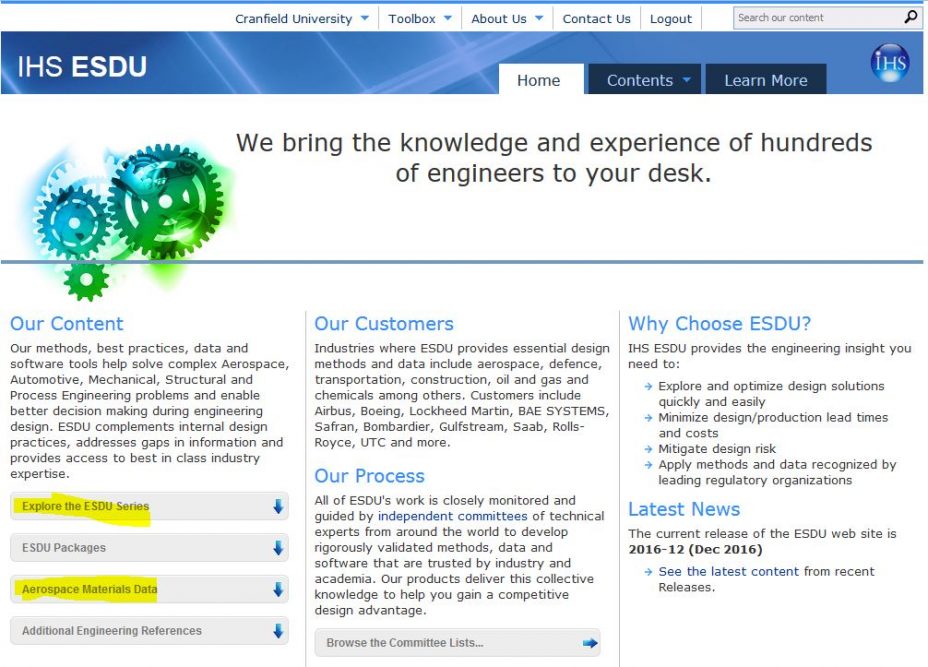ESDU – a fantastic resource for engineers!
07/12/2016

This is the first of a series of blog posts in which we will highlight some of our more specialist resources for engineers.
This one is all about ESDU. If you’re the kind of person who needs to find out how to calculate the strength of lugs under oblique load, or the lift-curve slope of swept and tapered wings, ESDU is the resource for you. It really is one of our ‘hidden gems’. It’s one of my favourite resources as it has helped me answer many tricky enquiries, and it gets such a great response when customers find the solution to their engineering design problem on it.
When I first started my Cranfield working life in the Kings Norton Library, ESDU stood for ‘Engineering Sciences Data Unit’ and comprised thousands of ‘data sheets’ which were filed away in hundreds of ring binders. Each time there was an update to a data sheet, ESDU sent us a new one and we would laboriously find the old version, throw it out and replace it with the new. Thankfully times have moved on and the service is now available online and is always up to date.
It contains fantastic information for engineers that really isn’t available elsewhere, and certainly not for free via a Google search. It’s a great place to go if you have an engineering problem that you want to solve, and it can save you lots of time and research by providing methods, worked examples and data. Its work is overseen by independent committees of technical experts (some of whom work at Cranfield), and is endorsed by the Royal Aeronautical Society, the Institution of Mechanical Engineers and the Institution of Chemical Engineers.
It contains equations, interactive graphs and software organised into 18 series. Experience has shown me that the best way to find what you need is to select the ‘Explore the ESDU series’ option and then browse to the information that you need.

‘Explore the ESDU Series’ and ‘Aerospace Materials Data’ options highlighted on the ESDU home page
The series are: aerodyamics, aircraft noise, composites, dynamics, fatigue – endurance data, fatigue – fracture mechanics, fluid mechanics (internal flow), fluid mechanics (internal flow – aerospace), heat transfer, mechanisms, performance, phyiscal data (chemical engineering), stress and strength, structures, transonic aerodynamics, tribology, vibration and acoustic fatigue and wind engineering.
Alongside the data sheets is another handy resource. The Metallic Materials Data Handbook (MMDH) can be found behind the ‘Aerospace Materials Data’ link and is a great source of metals property data for aerospace engineers, bringing lots of information that has been evaluated and meets design requirements together in one place.
ESDU itself provides videos and help and I am always happy to advise you and answer your questions. Contact me at e.turner@cranfield.ac.uk.
Public domain image from Unsplash.com
Categories & Tags:
Leave a comment on this post:
You might also like…
Keren Tuv: My Cranfield experience studying Renewable Energy
Hello, my name is Keren, I am from London, UK, and I am studying Renewable Energy MSc. My journey to discovering Cranfield University began when I first decided to return to academia to pursue ...
3D Metal Manufacturing in space: A look into the future
David Rico Sierra, Research Fellow in Additive Manufacturing, was recently involved in an exciting project to manufacture parts using 3D printers in space. Here he reflects on his time working with Airbus in Toulouse… ...
A Legacy of Courage: From India to Britain, Three Generations Find Their Home
My story begins with my grandfather, who plucked up the courage to travel aboard at the age of 22 and start a new life in the UK. I don’t think he would have thought that ...
Cranfield to JLR: mastering mechatronics for a dream career
My name is Jerin Tom, and in 2023 I graduated from Cranfield with an MSc in Automotive Mechatronics. Originally from India, I've always been fascinated by the world of automobiles. Why Cranfield and the ...
Bringing the vision of advanced air mobility closer to reality
Experts at Cranfield University led by Professor Antonios Tsourdos, Head of the Autonomous and Cyber-Physical Systems Centre, are part of the Air Mobility Ecosystem Consortium (AMEC), which aims to demonstrate the commercial and operational ...
Using grey literature in your research: A short guide
As you research and write your thesis, you might come across, or be looking for, ‘grey literature’. This is quite simply material that is either unpublished, or published but not in a commercial form. Types ...






